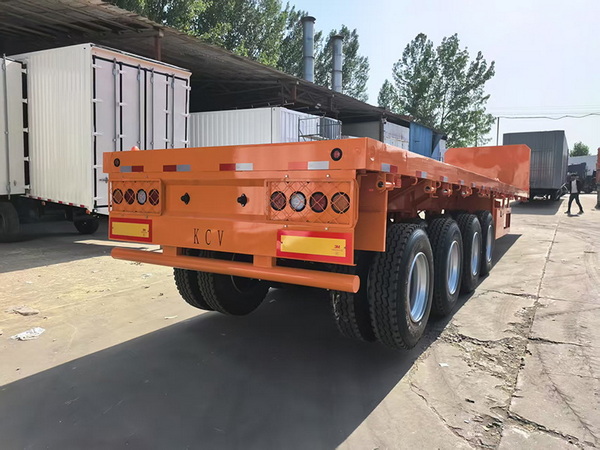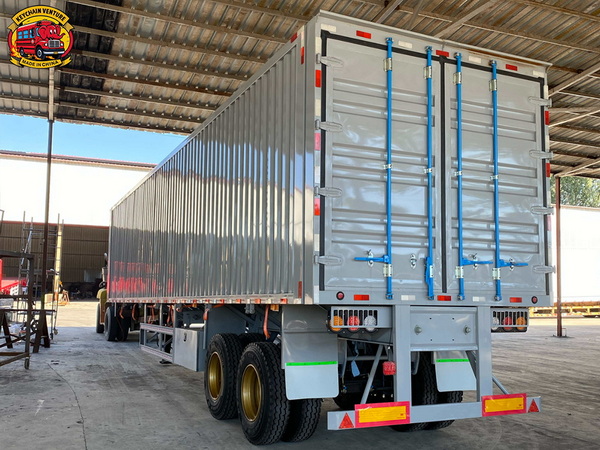Views: 222 Author: Amanda Publish Time: 2025-10-19 Origin: Site








Content Menu
● Standard Lengths of Semi Trailers
● Global Regulatory Length Limits
>> Europe
>> Asia
● Types of Semi Trailers and Their Typical Lengths
● Factors Affecting Semi Trailer Length
● Safety and Operational Implications of Semi Trailer Length
● Future Trends in Semi Trailer Length
● Frequently Asked Questions (FAQ)
>> 1. What is the typical maximum length of a semi trailer in the United States?
>> 2. Can semi trailers be longer than 80 feet?
>> 3. How long are semi trailers in Europe?
>> 4. What are the benefits of longer semi trailers?
>> 5. Are there safety concerns with longer semi trailers?
Semi trailers are indispensable assets in the global transportation and logistics industry, designed to haul vast quantities of goods efficiently over road networks. While the sheer scale of semi trailers may suggest that they can be of virtually any length, the reality is that their dimensions, especially length, are tightly regulated worldwide. These regulations balance the need for increased cargo capacity with road safety, infrastructure preservation, and operational efficiency. This article delves deeply into how long a semi trailer can be, exploring standard dimensions, regulatory frameworks across continents, types of trailers, practical factors affecting their length, and safety considerations.

A semi trailer is a kind of trailer that carries cargo but has no front wheels, relying on the tractor unit—or truck—for support at the front. This configuration enables more efficient hauling compared to full trailers because the tractor and trailer share the load, allowing for greater payloads and easier maneuvering. Semi trailers come in various types such as dry vans, flatbeds, tankers, refrigerated units, and extendable trailers, with each type varying in length and use.
The length of a semi trailer isn't standardized globally; it is influenced by national laws, cargo requirements, and trailer design choices. The most common lengths for semi trailers, however, fall within certain ranges:
- In the United States, the standard semi trailer length is typically 53 feet (about 16 meters) for dry vans and general freight trailers. This length offers a favorable balance between capacity and road compatibility.
- Shorter semi trailers known as pup trailers are around 28 feet long and often used in double or triple trailer configurations.
- Specialized semi trailers like extendable double drops or removable gooseneck trailers can stretch up to 80 feet or longer, mainly for oversized or heavy loads that exceed regular limits.
- The total length of the tractor and semi trailer combined generally ranges between 70 to 80 feet or slightly more.[9][10]
In the US, federal regulations primarily control semi trailer width, capping it at 8.5 feet. Length regulations vary by state but typically restrict single semi trailers to 53 feet length. The combined length restriction of truck plus trailer usually hovers around 70 to 80 feet depending on the state and vehicle configuration.
States have some latitude regarding length, and exceptions exist for certain special cargo and configurations, but maintaining both federal and state regulations is critical for legal operation.[1][9]
European regulations tend to be more restrictive on length but allow for innovative combinations under specific permits:
- The European Union generally limits semi trailer lengths to 13.6 meters (approximately 44.6 feet).
- However, countries like Sweden and Finland have exemptions permitting combinations up to 25.25 meters (83 feet) and weights of up to 60 tonnes. These are typically known as European Modular Systems (EMS) or EuroCombis and aim to improve freight efficiency while reducing carbon emissions.
- Germany and the Netherlands allow similar long haul combinations on designated routes with permits.
- In the United Kingdom, most semi trailers are about 45 feet (13.7 m) long, with combined tractor and trailer lengths between 50 and 55 feet. The UK has been experimenting with longer trailers up to 51 feet (15.65 m) in length under a government trial to evaluate environmental and economic benefits without exceeding the 44-tonne weight limit.[2][3][6]
Japanese semi trailers often adhere to the size limits of expressway classification, with common maximum lengths around 16.5 meters (54 feet). Length limits depend on the infrastructure and road type involved.[11]
- Countries like Australia and Canada generally follow similar length regulations to the US, with state or provincial variations.
- In certain South American and African countries, length regulations mimic international standards but may vary based on road conditions and enforcement policies.
Semi trailers come in several types, each optimized for different cargo and work environments, which impacts their length:
- Dry Van Trailers: The most prevalent type, primarily for palletized freight, measuring typically 53 feet long.
- Flatbed Trailers: Open trailers that usually range from 48 to 53 feet ideal for heavy machinery or oversized freight.
- Tanker Trailers: Designed to transport liquids, generally 48 to 53 feet long.
- Refrigerated Trailers (Reefers): Insulated and cooled trailers, commonly 48 to 53 feet.
- Pup Trailers: Small, about 28 feet long, used in multi-trailer configurations for flexibility and higher volume.
- Extendable or Specialized Trailers: Capable of stretching to transport very long or heavy loads, reaching up to 80 feet or more with modular designs.[12][9]

Several factors influence the practical and legal length of a semi trailer:
1. Legal Limits: Jurisdictional laws impose maximum trailer length, width, height, and weight to ensure safety and infrastructure integrity.
2. Cargo Type and Dimensions: Oversized or specialized cargo may require longer or modular trailers designed to adjust their length.
3. Vehicle Configuration: Some tractor units allow for longer trailer setups, including multi-trailer combinations.
4. Road Infrastructure: Bridge spans, turning radii, and road widths limit how long trailers can be operated safely.
5. Operational Efficiency: Balancing cargo capacity with maneuverability and fuel efficiency often dictates trailer dimensions.
Operating longer semi trailers requires heightened attention to safety for several reasons:
- Maneuvering: Longer vehicles demand more space for turns and lane changes.
- Braking Distances: Increased weight and length require longer stopping distances.
- Visibility: Drivers must manage blind spots more carefully.
- Infrastructure Wear: Longer and heavier trailers can stress roadways and bridges.
- Loading and Parking: Facilities must accommodate trailer size for efficient loading/unloading and parking.
Regulatory frameworks are designed to mitigate these risks through limits and special permits for oversized loads.
The pursuit of higher freight capacity alongside environmental concerns is shaping semi trailer designs and regulations:
- Longer and modular trailer combinations like EMS in Europe promise improved fuel economy and reduced emissions.
- Trials like the UK's longer semi-trailer trial aim to confirm economic and environmental benefits before wider adoption.
- Technological advancements in trailer materials and design allow for safer, stronger, and sometimes longer equipment.
- Automated and connected vehicle technologies may ease some of the operational challenges posed by longer semi trailers.
The question "How Long Can a Semi Trailer Be?" is answered differently depending on where you are in the world and the specific operational and regulatory context. Standard semi trailers typically measure between 48 and 53 feet, with combined vehicle lengths often stretching between 70 and 80 feet. However, some jurisdictions permit longer semi trailers, sometimes up to 83 feet or more, especially for modular or specialized trailers. Regulations balance the economic benefits of transporting more goods in fewer trips with the necessity of maintaining road safety, protecting infrastructure, and reducing environmental impact.
Understanding these variables is essential for logistics professionals, fleet managers, policymakers, and anyone involved in freight transportation. As innovation in trailer design and regulatory trials progress, the future may see more flexible and longer semi trailer configurations becoming standard within a safer and greener transport ecosystem.

In the US, the maximum length of standard semi trailers is usually 53 feet for the trailer alone, with a combined tractor and trailer length close to 70 to 80 feet depending on state laws and truck configuration.[1][9]
Yes, specialized trailers such as extendable double drops or removable goosenecks can be extended up to or beyond 80 feet for oversized loads, though they require special permits and routes.[9]
European semi trailers generally measure up to 13.6 meters (approximately 44.6 feet), but some countries allow longer modular combinations up to 25.25 meters (83 feet) under special rules.[3][2]
Longer semi trailers allow for increased cargo volume per trip, reducing the number of trips needed, which can lead to fuel savings, lower carbon emissions, and less road congestion.[2]
Yes, longer trailers require careful handling as they need more space for turning, longer braking distances, and may pose greater visibility challenges. Regulations are designed to mitigate these safety risks.[9]
[1](https://ops.fhwa.dot.gov/freight/publications/size_regs_final_rpt/)
[2](https://en.wikipedia.org/wiki/Semi-trailer_truck)
[3](https://www.tralert.com/en/blog/what-is-the-maximum-width-of-a-truck/)
[4](https://technical-regulation-information-system.ec.europa.eu/lv/notification/24526/text/D/EN)
[5](https://www.itf-oecd.org/sites/default/files/docs/dimensions-2019.pdf)
[6](https://www.gov.uk/government/collections/longer-semi-trailer-trial)
[7](https://www.logistiikanmaailma.fi/en/choosing-mode-of-transport/road-transport/dimensions-and-weights/)
[8](https://www.bta-international.com/en/information/dimensions-trucks-trailers/)
[9](https://schneiderjobs.com/blog/semi-truck-trailer-dimensions)
[10](https://ohiotiger.com/how-long-is-a-semi-truck/)
[11](https://www.mlit.go.jp/road/road_e/p7_vehicle.html)
[12](https://www.goodloading.com/en/blog/truck-transport/dimensions-and-types-of-semi-trailers/)